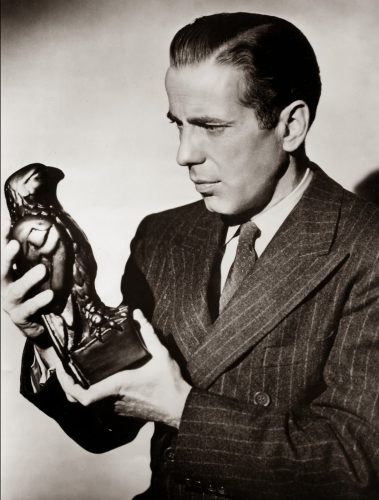Anyone a fan of The Maltese Falcon? How important is the Maltese Falcon in the story? Well, it’s ALL important and in the end, not important at all. The item itself turns out to have no real value to anyone—but what makes it important is it gets the characters and thus the plot moving! The Maltese Falcon is the quintessential MacGuffin. 
Hitchcock gave credit for the term to one of his screenwriters, but the idea of a MacGuffin predates Hitchcock. One source I found mentions Pearl White’s serial films which frequently used what she called a “weenie” as a device to get the action going, but I’m sure if we searched we could find numerous examples that predate The Perils of Pauline (her serials) too.
So, what is a MacGuffin and how do you use it?
A MacGuffin is something everyone in the story wants and are willing to do anything to get. It is an EXTERNAL GOAL that seems to have some wildly fabulous importance—although often, in the end, in reality, it doesn’t.
I used a MacGuffin in my second published novel. In it, my hero and heroine are both on the search for the Uhlrich Pig, a rare piece of art pottery that had been lost twenty years earlier. They are willing to lie, cheat and steal to get it.
What makes a MacGuffin work?
This intense desire for the MacGuffin makes it the perfect goal to drive a book—it is both Important to the character and Concrete—you know when they get. It is then up to you, the writer, to make sure the other two criteria for the perfect goal are met—Personal, give them a good motivation for needing this item and Urgent, give them a deadline to get it.
The other benefit of a MacGuffin is that it allows you do one of the greatest tricks for creating conflict—what I call, two dogs, one bone. Two or more characters want this thing, but only one can have it. With a MacGuffin, like the Falcon or my Pig, someone MUST lose.
Knowing that someone will lose is a must when building conflict. If the Falcon was instead a pot of gold and there was enough everyone could have had his or her share, it wouldn’t have worked. Who cares? Where is the race?
Does a MacGuffin have to be a thing?
Another example of a MacGuffin of sorts is Boo Radley in To Kill a Mockingbird. He is a “false” goal. The main story of the book isn’t really about Boo, but he, or the kids’ desire to get him to come out, gets the plot going. It gives the reader something to focus on while the rest of the story is being set into motion. (Boo does also serve the additional purpose of reinforcing the theme that real truth and perceived truth are not the same things. He also serves as something that stays the same throughout the book which gives the reader a measuring stick with which to see how much the point of view character, Scout has changed.)
As you can probably tell, I am a big fan of the MacGuffin. How about you? Have you written a story using this device? Or do you have another example to share?
~~~

Lori Devoti is the author of paranormal romance, urban fantasy and young adult fiction. Under the name Rae Davies, she writes the USA Today Bestselling Dusty Deals Mystery series. Check out her books at www.LoriDevoti.com and RaeDavies.com. Looking for help with your writing? Lori also does developmental editing and critiques for other authors and publishers. See our Editorial Services page for contact information and pricing. Or check out Lori’s classes at the Continuing Studies Department of the University of Wisconsin.

Interesting post. I will think about using it in a story I’m plotting.